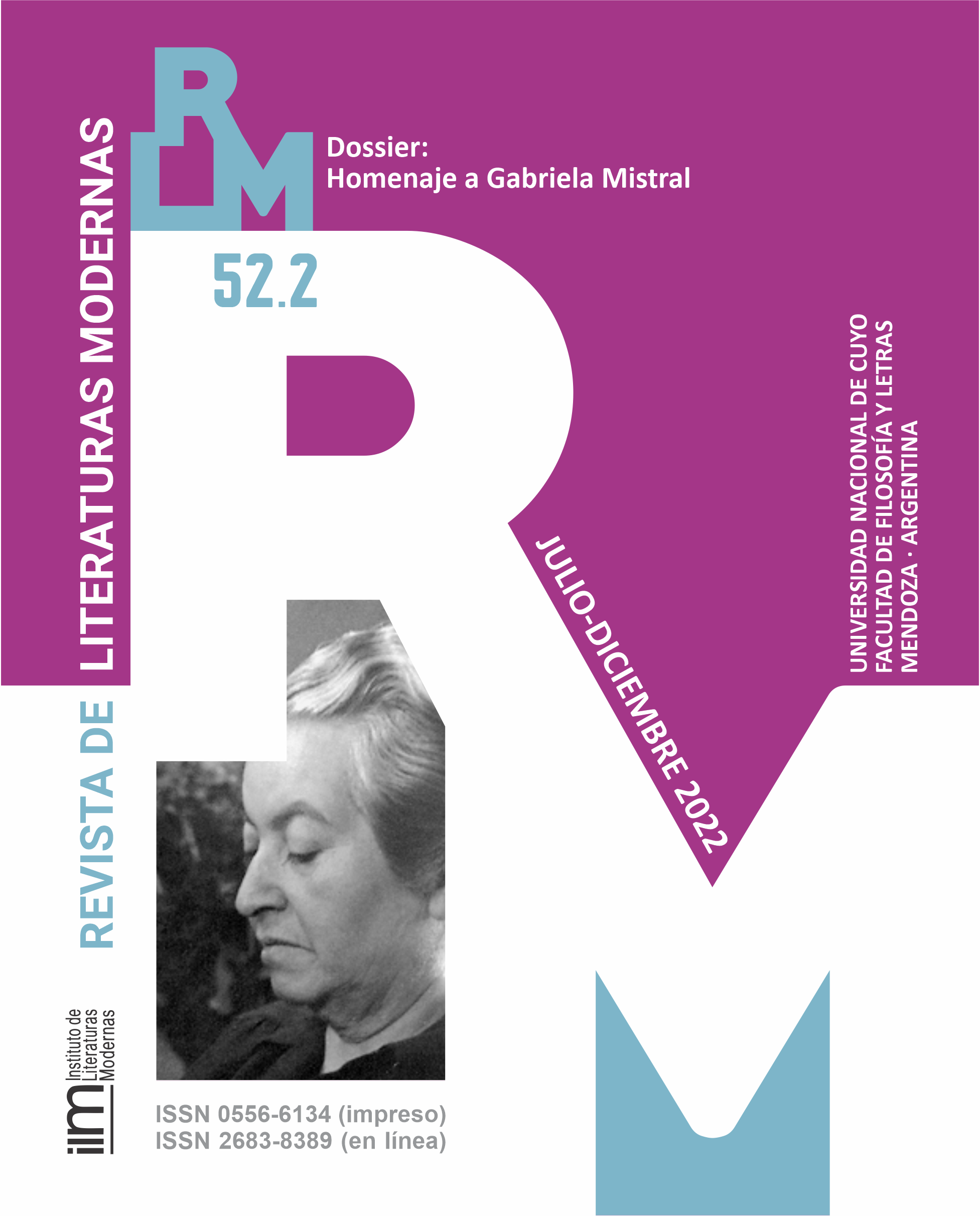Horror y distopía en la narrativa de Beatriz Ardesi
Palabras clave:
Narrativa mendocina, Gótico, Nueva novela ArgentinaResumen
La obra narrativa de la mendocina Beatriz Ardesi presenta rasgos renovadores que la destacan. En su segunda colección de relatos, Tres demonios [2021], explora nuevas posibilidades del realismo a partir de un fondo mítico, arquetípico, logrando un efecto esperpentizador de la realidad, explorándola en sus aspectos aparentemente más cotidianos, pero con una gran profundidad simbólica. Así, historias comunes llegan a convertirse en alegorías metafísicas: el primer microrrelato, que da título al volumen, nos instala de lleno en la atmósfera distópica que impregna la mayoría de los textos. La complicidad con el lector se logra a través del engañoso canto de sirenas que teje una primera persona verbal (protagonista o testigo) que nos atrapa con la pretendida inocencia de una conciencia incapaz de discernir verdad y mentira, realidad y ficción. El análisis abordará los procedimientos narrativos por los que se logra sumergir al lector en un ambiente ominoso: en primer lugar, la voz narrativa, responsable del efecto de horror que produce el texto, pero sin dejar de lado otros componentes esenciales: el espacio aterrador, verdadera “piedra de toque” del modo gótico, considerado no como simple topos sino como agente activo en el desenvolvimiento de las tramas.
Descargas
Citas
ARDESI, Beatriz. 2021. Tres demonios. Mendoza, Ediciones del Retortuño. Colección Piel de gallina.
AMÍCOLA, José. 2003. La batalla de los géneros; Novela gótica versus novela de educación. Rosario: Beatriz Viterbo Editora.
BOTTING, Fred. 2014. Gothic. New York: Routledge.
BUSTOS, Inti. 2020. “Monstruos, muertos y otras historias del borde: gótico y civilibarbarie. En ‘Bajo el agua negra’ de Marina Enríquez”. BOLETÍN GEC 25, Mendoza, jun.: 28-43.
CORTÁZAR, Julio. 1975. “Notas sobre lo gótico en el Rio de la Plata”. Caravelle. Cahiers du monde hispanique et luso-brésilien 25, Francia: 145-151.
DABOVE, Juan Pablo. 2018. “El gótico argentino contemporáneo”. RevistaREA 4 de octubre, Rosario, Santa Fe. En línea http://revistarea.com/el-gotico-argentino-contemporaneo/
DIEZ COBO, Rosa. María. 2020. “Arquitecturas del hogar invertido. Reescribiendo la casa encantada”. Brumal. Revista de Investigación sobre lo Fantástico Vol. VIII, nº 1 España, primavera / spring: 135-156.
DRUCAROFF, Elsa. 2011. Los prisioneros de la torre. Política, relatos y jóvenes en la postdictadura. Buenos Aires: Emecé.
ENRÍQUEZ, Mariana. 2018. “Creating a New Tradition of Latin American Horror”. Literary Hub, 31 octubre. En línea https://lithub.com/creating-a-new-tradition-of-latin-american-horror/
EUDAVE, Cecilia. 2018. “Hacia una clasificación del espacio en textos de horror fantástico”. Brumal. Revista de Investigación sobre lo Fantástico Vol. VI, nº 2, España, otoño / autumn: 57-73.
FOWLER, Alistair. 1982. Kins of Literature. An Introduction of the Theory of Genres and Modes. Oxford: Clarendon Press.
GARRIDO DOMÍNGUEZ, Antonio. 1996. El texto narrativo. Madrid: Síntesis.
GASPARINI, Sandra. 2014. “Casas y memoria: derivas del espacio y el miedo en la narrativa argentina contemporánea”. XXVI Jornadas de Investigadores del Instituto de Literatura Hispanoamericana Facultad de Filosofía y Letras (UBA) - Buenos Aires, marzo.
HODGSON, Eleanor. 2019. “Mariana Enríquez y el gótico urbano de Argentina”. En línea: https://scholar.colorado.edu/concern/undergraduate_honors_theses/pc289k00t. Consultado 2 de julio 2022.
OEYEN, Annelies. 2014. “Hacia una (est)ética del posapocalipsis en la narrativa argentina posdictatorial”. En Revista Iberoamericana 247, vol. LXXX, E.E.U.U, Abr. –Jun.: 631-651.
PÉREZ, Ezequiel. 2011. “Al pie de la escalera: ‘Las caras del miedo en la Nueva Narrativa Argentina’”. Actas del IV Seminario Internacional políticas de la memoria. Ampliación del campo de los derechos humanos. Memoria y perspectivas. Buenos Aires.
PUNTER, David. 2013 [1996]. The Literature of Terror. A History of Gothic Fictions from 1765 to the Present Day. Vol. II: The Modern Gothic. London: Routledge.
WESTPHALEN, Yolanda. 2017. “El horror de la memoria y las modernidades borderline”. Prado Alvarado, Agustín (coordinador). El cuento hispanoamericano del siglo xxi. América sin Nombre 22: 37-47, España. En línea http://dx.doi.org/10.14198/AMESN.2017.22.03
Descargas
Publicado
Cómo citar
Número
Sección
Licencia
Derechos de autor 2022 Marta Elena Castellino

Esta obra está bajo una licencia internacional Creative Commons Atribución-NoComercial-CompartirIgual 4.0.























